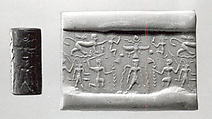Cylinder seal and modern impression: bearded deity flanked by kneeling heroes; Horus and monkeys; ibex-demon; sphinx trampling serpents
Not on view
Although engraved stones had been used as early as the seventh millennium B.C. to stamp impressions in clay, the invention in the fourth millennium B.C. of carved cylinders that could be rolled over clay allowed the development of more complex seal designs. These cylinder seals, first used in Mesopotamia, served as a mark of ownership or identification. Seals were either impressed on lumps of clay that were used to close jars, doors, and baskets, or they were rolled onto clay tablets that recorded information about commercial or legal transactions. The seals were often made of precious stones. Protective properties may have been ascribed to both the material itself and the carved designs. Seals are important to the study of ancient Near Eastern art because many examples survive from every period and can, therefore, help to define chronological phases. Often preserving imagery no longer extant in any other medium, they serve as a visual chronicle of style and iconography.
The modern impression of the seal is shown so that the entire design can be seen. This seal shows a complex scene. A two-faced nude bearded and belted deity with streams flowing from his shoulders is flanked by two kneeling nude belted male figures holding lotus flowers and spears. Above this scene a Horus falcon with outspread wings, surmounted by a crescent with disc, is flanked by two squatting monkeys and stars. A smaller nude figure with a caprid head holding a mace strides behind a kneeling figure. Above him, a sphinx strides on two snakes.
Due to rights restrictions, this image cannot be enlarged, viewed at full screen, or downloaded.

